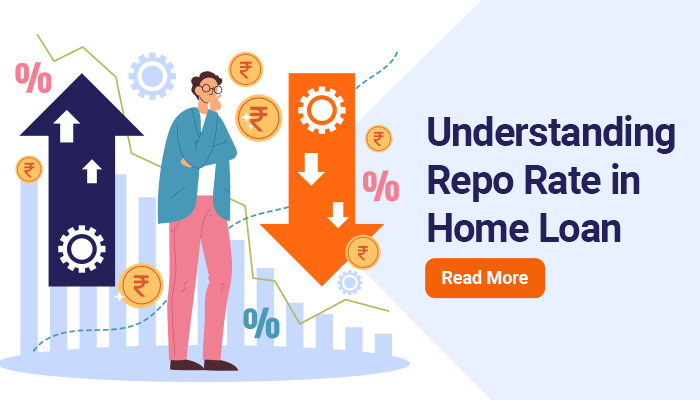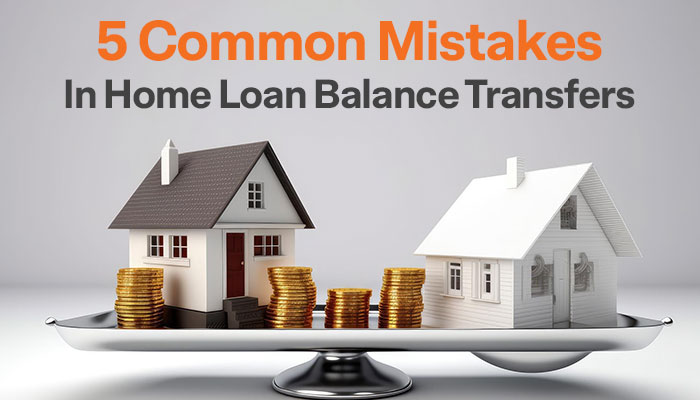Home Loans and Repo Rates: What's the Connection?

Owning a home is a big step, and a home loan helps you borrow the money to make it happen. You pay it back over time. Before getting one, check if it's affordable, which depends on the current interest rates.
One key factor affecting home loan interest rates is the repo rate. Central banks use this rate to manage the economy. When it changes, it directly affects the interest rates banks offer for home loans.
This article will provide the nitty-gritty of the repo rate, explaining its effect on home loans, the current repo rate in India, and other relevant information. Explore this topic and check your home loan eligibility with the IIFL Home Loans.

Understanding Repo and Reverse Repo Rate
The repo rate is the interest rate at which banks borrow money from the Reserve Bank of India (RBI) through repurchasing agreements or options.
The reverse repo rate is the interest rate commercial banks charge when the central bank borrows funds from them. The repo rate can be adjusted by the central bank to influence the lending rates of commercial banks. This, in turn, affects the borrowing and spending of the economy.
How Does Repo Rate Work?
The repo rate indicates the interest rate at which the Reserve Bank of India (RBI) lends short-term funds to commercial banks, helping them maintain adequate liquidity for day-to-day operations and aiding in controlling inflation.
The repo rate is the interest rate at which the Reserve Bank of India (RBI) lends short-term funds to commercial banks. This helps banks maintain sufficient liquidity for their daily operations and assists in controlling inflation.
During inflationary periods, the RBI may choose to increase the repo rate, leading to higher borrowing costs for businesses. This could decrease economic spending and investment. Conversely, during a recessionary period, the RBI may decrease the repo rate to reduce borrowing costs. This would encourage businesses to borrow and spend more, increasing money circulation in the market and boosting overall economic activity.
Comprehending Repo Rate and Reverse Repo Rate
The following table outlines the key differences between the repo rate and the reverse repo rate.:
| Parameters | Repo Rate | Reverse Repo Rate |
| Definition | The rate at which banks borrow funds from the central bank by selling their securities with an agreement to repurchase them at a later date. | The rate at which the central bank borrows funds from commercial banks by selling securities with a commitment to repurchase them later. |
| Effect on Economy | Lowering the repo rate can stimulate spending and investment, whereas raising it can help control inflation. | Lowering the reverse repo rate can discourage banks from keeping excess funds with the central bank, encouraging lending, while raising it can help control excess liquidity in the market. |
| Impact on Interest Rates | Changes in the repo rate can lead to changes in the interest rates of loans and deposits in the banking sector. | Changes in the reverse repo rate do not have a direct impact on the interest rates of loans and deposits but affect the overall liquidity in the banking sector. |
Current Repo Rate in India
Below is the table indicating the prevailing repo rate and reverse repo rate in India:
| Parameters | Rate |
| Repo Rate | 6.50% as per the latest announcement by the Reserve Bank of India (RBI) on December 1, 2023 |
| Reverse Repo Rate | 3.35% |
How Does Repo Rate Impact Home Loan?
The following pointers explain how the repo rate affects home loans:
EMI:
- Increased repo rate affects higher home loan repo rate, increasing the EMI.
- A lower repo rate decreases home loan interest rates, reducing the EMI.
Interest Rate:
- Higher repo rate elevates RBI home loan interest rates 2023, increasing interest payments.
- A lower repo rate reduces home loan interest rates, decreasing interest payments.
Loan Eligibility:
- Lower loan eligibility due to higher interest rates.
- A lower repo rate enhances loan eligibility with favorable interest rates.
Loan Affordability:
- Higher repo rate decreases home loan affordability due to increased borrowing costs.
- A lower repo rate improves home loan affordability with reduced borrowing costs.

Closing Thoughts
Understanding the dynamics of the current repo rate in India is crucial for prospective home buyers. The repo rate significantly influences the RBI home loan interest rate 2023, which affects the affordability, eligibility, and monthly installments of a home loan. Knowing about the repo rate for a home loan and its implications can guide you in making an informed decision when considering financing options for purchasing a home.
Explore IIFL Home Loan for attractive rates and flexible repayment options They offer attractive interest rates and flexible repayment options for your needs. Your dream home may be a click away!
FAQs
Q1. Who decides the repo rate in India?
The repo rate in India is decided by the Reserve Bank of India's Monetary Policy Committee (MPC) during its bi-monthly monetary policy meetings.
Q2. How often is the repo rate reviewed in India?
The repo rate is reviewed once in every two months (six times a year) by the Monetary Policy Committee of the Reserve Bank of India.
Q3. Does a change in the repo rate affect existing loan borrowers?
Yes, a change in the repo rate can affect existing loan borrowers, especially if they have loans with floating interest rates. A change in the repo rate can lead to a corresponding change in loan interest rates.
Q4. How does the repo rate affect the common man?
The repo rate affects the common man by influencing the interest rates on loans and deposits. A lower repo rate might lead to lower interest rates on loans, while a higher repo rate could make borrowing more expensive and savings more lucrative.
Tags
Disclaimer: The information contained in this post is for general information purposes only. IIFL Home Finance Limited (including its associates and affiliates) ("the Company") assumes no liability or responsibility for any errors or omissions in the contents of this post and under no circumstances shall the Company be liable for any damage, loss, injury or disappointment, etc. suffered by any reader. All information in this post is provided "as is", with no guarantee of completeness, accuracy, timeliness, or of the results, etc. obtained from the use of this information, and without warranty of any kind, express or implied, including, but not limited to warranties of performance, merchantability, and fitness for a particular purpose. Given the changing nature of laws, rules, and regulations, there may be delays, omissions, or inaccuracies in the information contained in this post. The information on this post is provided with the understanding that the Company is not herein engaged in rendering legal, accounting, tax, or other professional advice and services. As such, it should not be used as a substitute for consultation with professional accounting, tax, legal or other competent advisers. This post may contain views and opinions which are those of the authors and do not necessarily reflect the official policy or position of any other agency or organization. This post may also contain links to external websites that are not provided or maintained by or in any way affiliated with the Company and the Company does not guarantee the accuracy, relevance, timeliness, or completeness of any information on these external websites. Any/ all (Home/ Loan Against Property/ Secured Business Loan/ Balance Transfer/ Home Improvement Loan/ NRI Home Loan/ Home Loan for Uniformed Services) loan product specifications and information that may be stated in this post are subject to change from time to time, readers are advised to reach out to the Company for current specifications of the said (Home/ Loan Against Property/ Secured Business Loan/ Balance Transfer/ Home Improvement Loan/ NRI Home Loan/ Home Loan for Uniformed Services) loan.
 Login
Login






















